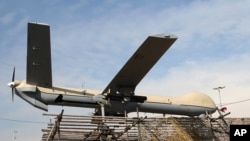An unarmed Iranian drone shadowed a U.S. aircraft carrier at night and came close enough to F-18 fighter jets to put the lives of American pilots at risk, the Navy said Tuesday, reporting the second such tense encounter within a week.
The Iranian Sadegh drone flew without any warning lights during the encounter Sunday night with the USS Nimitz, said Lt. Ian McConnaughey, a spokesman for the Bahrain-based 5th Fleet.
The drone did not respond to repeated calls over the radio and came within 1,000 feet (300 meters) of U.S. fighters, he said.
'Dangerous situation'
That “created a dangerous situation with the potential for collision and is not in keeping with international maritime customs and laws,” McConnaughey said in a statement.
The drone was unarmed, the lieutenant said, though that model can carry missiles.
Iran's military and state-run media did not immediately report the incident, which came after a similar encounter Aug. 8, in which the Navy said an Iranian drone came within 100 feet (30 meters) of an F-18 preparing to land on the Nimitz. Iranian vessels and U.S. warships have also had tense encounters in recent months.
U.S. President Donald Trump has threatened to renegotiate the nuclear deal struck by his predecessor amid new sanctions targeting Iran over its ballistic missile tests.
14 encounters during 2017
So far this year, the Navy has recorded 14 instances of what it describes as “unsafe and/or unprofessional” interactions with Iranians forces. It recorded 35 in 2016 and 23 in 2015.
The incidents at sea almost always involved Iran's Revolutionary Guard, a paramilitary force that reports only to Supreme Leader Ayatollah Ali Khamenei. Some analysts believe the incidents are meant in part to squeeze moderate President Hassan Rouhani's administration after the 2015 nuclear deal.
Of the incidents at sea last year, the worst involved Iranian forces capturing and holding overnight 10 U.S. sailors who strayed into the Islamic Republic's territorial waters.
Iranian forces in turn accuse the U.S. Navy of unprofessional behavior, especially in the Strait of Hormuz, the mouth of the Persian Gulf, through which a third of all oil traded by sea passes.








